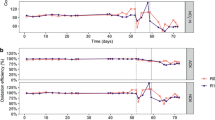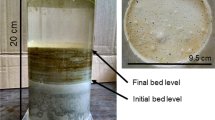Abstract
In small streams, the majority of carbon turnover is due to microbial activity in biofilms. Flow velocity is a key factor influencing biofilm function, and nascent biofilms with high energy need for growth might be especially sensitive to hydrodynamics. The major part of carbon supply is allochthonous but algae can provide easily available exudates for biofilm bacteria. In this study, epilithic biofilms were grown for 2 weeks in a third order stream in Thuringia, Germany, and then incubated in replicate flow channels in climate-controlled chambers. Glucose and arbinose were added immediately to all channels, and the effects of flow velocity and light availability on rates of sugar removal were examined. Phosphate addition did not influence sugar decrease rates. Flow velocities of either 0.3 m s−1 or 0.7 m s−1 resulted in 1.3 to 3.1 times higher decrease rates under the higher flow velocity. Light exclusion resulted in a 2.2 to 2.6 times faster sugar decrease but only a 0.5 times dissolved organic carbon increase compared to channels with light input, suggesting a strong internal coupling of primary producers and heterotrophs. Our results indicate that carbon uptake from the water column is fostered at higher flow velocities and that primary production is an important internal carbon source in nascent epilithic biofilms.



Similar content being viewed by others
References
Augspurger C, Gleixner G, Kramer C, Küsel K (2008) Tracking carbon flow in a 2-week-old and 6-week-old stream biofilm food web. Limnol Oceanogr 53:642–650
Battin TJ, Kaplan LA, Newbold JD, Cheng X, Hansen C (2003) Effects of current velocity on the nascent architecture of stream microbial biofilms. Appl Environ Microbiol 69:5443–5452
Besemer K, Singer G, Limberger R, Chlup A-K, Hochedlinger G, Hödl I, Baranyi C, Battin TJ (2007) Biophysical controls on community succession in stream biofilms. Appl Environ Microbiol 73:4966–4974
Beyenal H, Lewandowski Z (2002) Internal and external mass transfer in biofilms grown at various flow velocities. Biotechnol Prog 18:55–61
Boston HL, Hill WR (1991) Photosynthesis light relations of stream periphyton communities. Limnol Oceanogr 36:644–656
Carr GM, Morin A, Chambers PA (2005) Bacteria and algae in stream periphyton along a nutrient gradient. Freshw Biol 50:1337–1350
Clesceri LS, Greenberg AE, Eaton AD (1998) Standard methods: for the examination of water and wastewater, 20th edn. American Public Health Association, Washington, DC, 1325 pp
Costerton JW, Lewandowski Z, Caldwell DE, Korber DR, Lappin-Scott HM (1995) Microbial biofilms. Annu Rev Microbiol 49:711–745
Fischer H, Sachse A, Steinberg CEW, Pusch M (2002) Differential retention and utilization of dissolved organic carbon by bacteria in river sediments. Limnol Oceanogr 47:1702–1711
Fletcher M (1986) Measurement of glucose utilization by Pseudomonas fluorescens that are free-living and that are attached to surfaces. Appl Environ Microbiol 52:672–676
Fukuda M, Ashida A, Tomaru Y, Nakano S (2004) An improved method for collecting heterotrophic microorganisms living on pebbles in streams. Limnology 5:41–46
Gantzer CJ, Rittmann BE, Herricks EE (1988) Mass transport to streambed biofilms. Water Res 22:709–722
Geesey GG, Mutch R, Costerton JW, Green RB (1978) Sessile bacteria—important component of microbial population in small mountain streams. Limnol Oceanogr 23:1214–1223
Hoppe H-G (1983) Significance of exoenzymatic activities in the ecology of brakish water: measurements by means of methylumbelliferyl-substrates. Mar Ecol Prog Ser 11:299–308
Hunt AP, Parry JD (1998) The effect of substratum roughness and river flow rate on the development of a freshwater biofilm community. Biofouling 12:287–303
Jones SE, Lock MA (1993) Seasonal determinations of extracellular hydrolytic activities in heterotrophic and mixed heterotrophic/autotrophic biofilms from two contrasting rivers. Hydrobiologia 257:1–16
Kaplan LA, Newbold JD (2002) The role of monomers in stream ecosystem metabolism. In: Findlay SEG, Sinsabaugh RL (eds) Aquatic ecosystems: interactivity of dissolved organic matter. Academic Press, San Diego, pp 97–119
Magilligan FJ, Nislow K (2001) Long-term changes in the regional hydrologic regime following impoundment in a humic-climate watershed. J Am Water Resour Assoc 37:1551–1570
Mindl B, Sonntag B, Pernthaler J, Vrba J, Psenner R, Posch T (2005) Effects of phosphorus loading on interactions of algae and bacteria: reinvestigation of the ‘phytoplankton-bacteria paradox’ in a continuous cultivation system. Aquat Microb Ecol 38:203–213
Pohlon E, Augspurger C, Risse-Buhl U, Arle J, Willkomm M, Halle S, Küsel K (2007) Querying the obvious: lessons from a degraded stream. Restor Ecol 15:312–316
Porter KG, Feig YS (1980) The use of DAPI for identifying and counting aquatic microflora. Limnol Oceanogr 25:943–948
Reiche M, Torburg G, Küsel K (2008) Competition of Fe(III) reduction and methanogenesis in an acidic fen. FEMS Microbiol Ecol 65:88–101
Romaní AM, Sabater S (1999) Epilithic ectoenzyme activity in a nutrient-rich Mediterranean river. Aquat Sci 61:122–132
Romaní AM, Guasch H, Muñoz I, Ruana J, Vilata E, Schwartz T, Emtiazi F, Sabater S (2004) Biofilm structure and function and possible implications for riverine DOC dynamics. Microb Ecol 47:316–328
Spänhoff B, Augspurger C, Küsel K (2007) Comparing field and laboratory breakdown rates of coarse particulate organic matter: sediment dynamics mask the impacts of dissolved nutrients on CPOM mass loss in streams. Aquat Sci 69:495–502
Sundh I, Bell RT (1992) Extracellular dissolved organic carbon released from phytoplankton as a source of carbon for heterotrophic bacteria in lakes of different humic content. Hydrobiologia 229:93–106
Tank JL, Dodds WK (2003) Nutrient limitation of epilithic and epixylic biofilms in ten North American streams. Freshw Biol 48:1031–1049
Wetzel RG (1992) Gradient-dominated ecosystems: sources and regulatory functions of dissolved organic matter in freshwater ecosystems. Hydrobiologia 229:181–198
Acknowledgments
The authors are thankful to Anne Huchel, Andrea Scheibe and Pascal Weigand for assistance in both field and laboratory, and two anonymous reviewers for their helpful comments. Sven Rau provided excellent technical support for the phosphatase activity measurement. This work was supported by a grant from the Deutsche Forschungsgemeinschaft DFG (266/3).
Author information
Authors and Affiliations
Corresponding author
Rights and permissions
About this article
Cite this article
Augspurger, C., Küsel, K. Flow velocity and primary production influences carbon utilization in nascent epilithic stream biofilms. Aquat. Sci. 72, 237–243 (2010). https://doi.org/10.1007/s00027-009-0126-y
Received:
Accepted:
Published:
Issue Date:
DOI: https://doi.org/10.1007/s00027-009-0126-y




